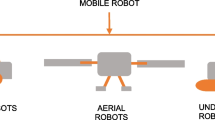Abstract
In the past few years, the field of autonomous robot has been rigorously studied and non-industrial applications of robotics are rapidly emerging. One of the most interesting aspects of this field is the development of the learning ability which enables robots to autonomously adapt to given environments without human guidance. As opposed to the conventional methods of robots’ control, where human logically design the behavior of a robot, the ability to acquire action strategies through some learning processes will not only significantly reduce the production costs of robots but also improves the applicability of robots in wider tasks and environments. However, learning algorithms usually require large calculation cost, which make them unsuitable for robots with limited resources. In this study, we propose a simple two-layered neural network that implements a novel and fast Reinforcement Learning. The proposed learning method requires significantly less calculation resources, hence is applicable to small physical robots running in the real world environments. For this study, we built several simple robots and implemented the proposed learning mechanism to them. In the experiments, to evaluate the efficacy of the proposed learning mechanism, several robots were simultaneously trained to acquire obstacle avoidance strategies in the same environment, thus, forming a dynamic environment where the learning task is substantially harder than in the case of learning in a static environment and promising result was obtained.
Similar content being viewed by others
References
Ackley D, Littman M (1992) Interactions between learning and evolution. In: Langton CG, Taylor C, Farmer CD, Rasmussen S (eds). Artificial life II, Addison-Wesley, Reading, MA, pp 487–509
Elman J (1990) Finding structure in time. Cogn Sci 14: 179–211
Hartono P, Kakita S (2008) Embedded neural network for swarm learning of physical robots. Proc Int. Conf Artif Neural Netw 2008(2): 141–149
Hartono P, Tabe K, Suzuki K, Hashimoto S (2003) Strategy acquirement by survival robots in outdoor environment. Proc IEEE Int Conf Robot Autom 3: 3571–3575
Kamio S, Iba H (2005) Adaptation technique for integrating genetic programming and reinforcement learning for real robots. IEEE Trans Evol Comput 9(3): 318–333
Kube C, Bonabeau E (2000) Cooperative transport by ants and robots. Robot Autonom Syst 30: 85–101
Morimoto J, Cheng G, Atkeson G, Zeglin G (2004) A simple reinforcement learning algorithm for biped walking. Proceedings of the IEEE international conference on robotics and automation, pp 3030–3035
Nakatani M, Suzuki K, Hashimoto S (2003) Subjective-evaluation oriented teaching scheme for a biped humanoid robot. Proceedings of the 2003 IEEE-RAS international conference on humanoid robots
Nakamura A, Ota J, Arai T (2002) Human-supervised multiple robot system. IEEE Trans Robot Autom 18(5): 728–743
Nolfi S, Parisi D (1997) Learning to adapt to changing environments in evolving neural networks. Adapt Behav 5: 99–105
Pettersson J, Wahde M (2005) Application of the utility function method for behavioral organization in a locomotion task. IEEE Trans Evol Comput 9(5): 506–521
Qiao J, Hou Z, Ruan X (2008) Application of reinforcement learning based on neural network to dynamic obstacle avoidance. Proceedings of the IEEE international conference on information and automation, pp 784–788
Smart WD, Kaelbling LP (2002) Effective reinforcement learning for mobile robots. Proc IEEE Int Conf Robot Autom 4: 3404–3410
Sutton RS, Barto AG (1998) Reinforcement learning: an introduction. MIT Press, Cambridge
Stent GS (1973) A physiological mechanism for Hebb’s postulate of learning. Proc Natl Acad Sci USA 70: 997–1001
Widrow B, Winter R, Baxter R (1998) Layered neural nets for pattern recognition. IEEE Trans Acoust Speech Signal Process 36(7): 1109–1118
Yamaguchi T, Masubuchi M, Fujihara K, Yachida M (2006) Realtime reinforcement learning for a real robot in the real environment. Proceedings of the IEEE international conference on intelligent robots and systems, pp 1321–1328
Author information
Authors and Affiliations
Corresponding author
Rights and permissions
About this article
Cite this article
Hartono, P., Kakita, S. Fast reinforcement learning for simple physical robots. Memetic Comp. 1, 305–313 (2009). https://doi.org/10.1007/s12293-009-0015-x
Received:
Accepted:
Published:
Issue Date:
DOI: https://doi.org/10.1007/s12293-009-0015-x




